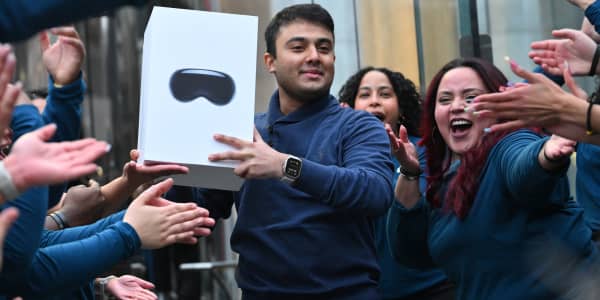With few exceptions, top-selling smartphone models from Apple, Samsung, Huawei and the rest — a sea of rectangular slabs with rounded corners and maybe a bezel — lately have reached the limits when it comes to impressing consumers with new design elements to stand out.
Now they are all about the screen.
According to Brett Newman, co-founder of product design firm Daylight Design, the screen is "the point of interface, the centerpiece of the design." Most buyers just want a screen that's durable enough not to crack when dropped, coupled with two diametrically opposed design elements: a bigger, richer screen on which to consume media, but which also lays atop a smaller handset that fits within a palm or pocket. The latter problem is getting closer to being solved.
All the major smartphone makers are quietly working on foldable phones, devices that might use two or more bendable OLED panels that form a large screen when unfolded, according to recent reports. Huawei might have something to show us in October, Samsung's foldable Galaxy X is reportedly due for launch sometime in 2018 or 2019, and Apple's version could come as soon as 2020.
Apple and Samsung declined to comment.
If these devices work well, look sleek and offer a user experience that's as rich or richer than what our iPhone X and Galaxy 8's provide, a flood of phones with 6-inch or 7-inch screens that scrunch down into 3.5- or 4-inch forms might have the potential to shake up the saturated smartphone sector.
"Foldable phones could be the future," Newman said. "But they need to meet the current standards of performance and specifications and be foldable to be widely accepted. If they do both, there is a chance for a significant, sustained meaningful change in the market," he added.
There's no doubt that consumers and Wall Street would welcome the debut of a relevant, cutting-edge form factor in the global smartphone market, where shipments have waned due to fewer smartphone converts and fewer people willing to upgrade as often. According to IDC, vendors shipped 334.3 million units during the first quarter of 2018, a 2.9 percent decline over the prior year's first quarter. China drove the decline, where shipment volumes dipped below 100 million — a low not seen since late 2013.
"The abundance of ultra-high-end flagships with big price tags released over the past 12 to 18 months has most likely halted the upgrade cycle in the near term," IDC said in its most recent Worldwide Quarterly Mobile Phone Tracker. "It now looks as if consumers are not willing to shell out this kind of money for a new device that brings minimal upgrades over their current device."
The foldable phone is almost a reality
A foldable phone powered by technology that delights users might tip the scales up — at least a bit.
"You only have to look at the other core electronic devices with screens — computers, TVs, tablets — to know that once you get saturation, there is never going to be this huge explosion of demand for these products," said Stephen Baker, v.p. and industry advisor for technology and mobile at market research firm NPD Group. "[Foldable phones] will be great, awesome products, but I'm sure it will be a slow burn in terms of both the interest level and people's acceptance. But this is the kind of stuff you do as a consumer electronics company — you advance the product."
There have been a handful of dual-screened, hinged phones released over the past decade, but all have sacrificed too many features to be up to snuff to their one-interface counterparts. ZTE's Axon M, introduced in October, got the market a little closer with its two 5.2-inch LCD screens that form a 6.75-inch tablet when opened.
The ZTE Axon M is not a true flexible phone — the second screen slides out from the back and is attached with a bulky hinge. And with a price tag of $725, a few shortcomings won't help convince consumers: its displays are lower resolution than most 2017 phones, while the life of its battery, which must power two screens, is expected to be significantly shorter. ZTE also is currently in a fight for its life as the U.S.-China trade war evolves, with a proposed U.S. ban on its use of American technology components posing an existential threat.
The biggest design challenge with foldable smartphones is with screens, which like on all high-end models, are made up of various layers of glass and/or polymer films.
"Developing any glass to bend at a tight radius hundreds of thousands of times without significant damage, and while maintaining outstanding optical properties, is a challenge," said a Corning spokeswoman. Challenges also exist within the foldable device. The display panel and electrodes, for example, must all meet the same bendability requirements, without compromising display quality, while the bend hinge should not show signs of creasing.
"The key is, how good is that display going to be?" said Wai-Loong Lim, co-founder of R&D consultancy Y Studios. "To fold in the middle, to crease it in the middle, is it going to provide the rich visual experience — the depth, the immersion — that we want?"
More from Tech Drivers:
Apple will automatically share a user's location in emergency when calling 911
Facebook is getting into the television news business
The complicated truth about Sophia the heavily hyped robot
Materials break at their weakest points, and as glass gets thinner — a necessary trait for a display that bends almost in half — it becomes more vulnerable to being punctured. "A foldable display is something like a sandwich with many functional layers," said Calvin Hsieh, a director at research firm IHS Markit. "These layers have to bear bending for several times."
Foldable phones are likely to be based on OLED screens, which presents another problem, according to David McQueen, a research director at ABI Research. The OLED layer is semipermeable, which makes it susceptible to moisture leaks. Major display manufacturers — LG Display, Samsung and Royole, to name a few — are examining ways to coat interfaces with protective barriers.
Folding a display 280 times a day
Folding a display 200,000 times without damage — opening and closing the phone about 280 times a day to meet a two-year device warranty — is an early expectation. Hsieh says that mechanical designs haven't quite gotten there, although German glassmaker giant Schott says its materials are ready.
"Whatever foldable device that comes to market next year, if it has a glass cover, most likely it will be from Schott," said Jose Zimmer, a vice president Schott Thin Glass & Wafer.
The firm developed a production technique that draws down the thickness of its glass significantly to less than 100 micrometers (versus the 300 to 400 that today's smartphone cover glass features). Laminates chemically strengthen its display material. Schott's flexible glass has undergone bend tests of up to 100,000 times.
Corning, the display glass market leader, is still working to find the optimal tradeoff between beauty and function for foldable glass. "We can make foldable displays, but they tend not to be that compelling versus what you can have today," said CEO Wendell Weeks on the company's latest quarterly conference call in April. "And if we try to make a very compelling form factor, they tend not to be durable enough. We're a long way from having a really compelling product here."
"[A manufacturer] might have the right answer, but is it compatible with all the other things that go on in a device and can you scale it?" said William Stofega, program director for IDC's mobile device technology and trends research program. "What we really need is something that's not a lab experiment; something that can be produced in volume. It's a process."
Royole, a six-year old manufacturer, says flexible displays are production-ready; they're just waiting for the rest of the supply chain to catch up.
"Before flexible/bendable displays became available for commercialization, it was difficult for manufacturers to work on consumer product design to even begin to find out what potential issues may be," said Ze Yuan, Royole's director of R&D. "Now the situation has changed. We are ready to offer our display products, know-how, and IP for product integration. This is one area that can be built up quickly, not only for us, but also for a lot of different industries."
While much of smartphone innards have become somewhat more bendy and small over time —soft circuit boards, more flexible batteries — a foldable phone's enclosure needs to be somewhat lithe but also durable enough to keep the phone's inner screen protected. If done right, that could be a major selling point.
"The glass of current smartphones' screens is the bane of all existence — you have this beautiful jewel of a phone that you have to put a case on," says Daylight's Newman. "There is a place for a foldable screen [in the market] if it can provide a more secure shell for your phone such that you're not walking about with a piece of glass exposed in your pocket."
Tech designers and analysts say that bendable smartphones with truly continuous screens will probably come with the second- or third-generation of foldables, when the mechanical design detailing a screen's bend radius has been fully ironed out. And then, smartphone design may have reached its limit. "As design moves to a digital world where industrial design is just the housing or frame for a compelling user experience, design moves into the background," Newman said.
Foldable phones need to be capable of delivering whatever next-gen technology developers are pursuing, like 5G, AI and augmented reality, which Apple is pushing with its latest ARKit 2 platform.
"A flexible smartphone is cool, but it has to be backed up by services and features that actually deliver — otherwise, it's just a gimmick," said Y Studios' Lim.




